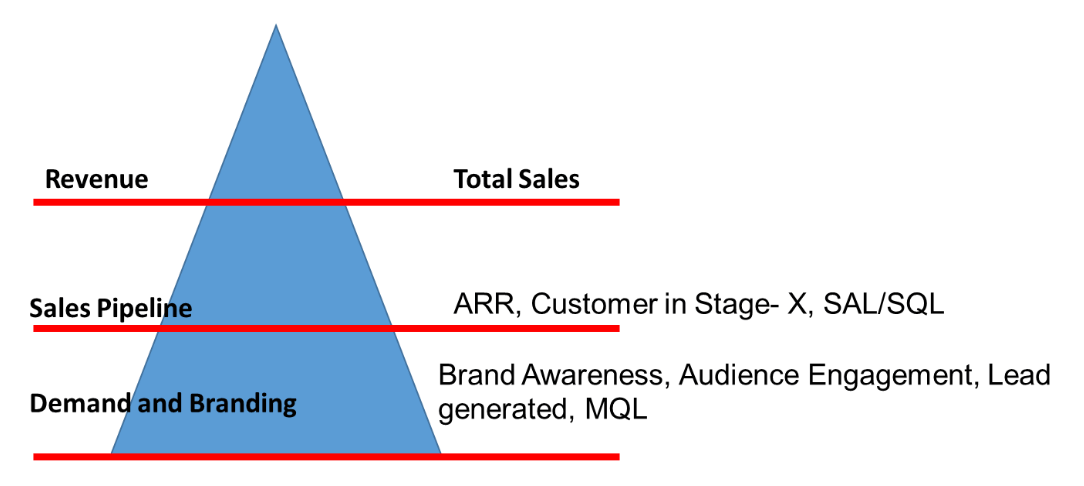Famous management thinker Peter Drucker once said, “If you can’t measure it, you can’t improve it.” And he was damn right.
If you want to ensure you’re moving towards achieving your goals, you need to constantly monitor your actions. Only then you can improve, adapt, and optimize your strategies. The philosophy applies to all departments such as development, operation, sales, and product marketing.
It doesn’t matter if you’re a new product marketer or a senior marketer who is overwhelmed with a lot of metrics; I hope this blog will be helpful for you for the following pointers we are going to discuss:
- The importance of metrics
- Why you should avoid measuring everything under the sun
- A common pitfall in choosing product marketing KPIs
- The 4 golden metrics (tried and tested) for B2B product marketers
Why are metrics important for product marketing?
To understand the importance of tracking KPIs of product marketing today, we’ll first look at demand-supply economics.
Demand-supply economics
Before the public cloud (AWS, Azure, Google Cloud), producing B2B software products was costly and time-consuming. Customers used to take at least six months or more to make a purchase decision, with revenue generation heavily dependent on the sales force.
Product marketing was primarily a support function for helping sales folks with market research, preparing sales-enablement documents, and creating unique positioning and messaging for the product.
Support and research functions are usually subjective and difficult to measure. Although customer acquisition is considered teamwork, the credit always went to the salesperson who initiated the call with the lead. In such cases, the product marketing function was traditionally seen as a desk role and a support function for sales and event marketers.
But after the cloud, the ability to build software has gone up, and due to this, the supply of software products also surged. This ease of developing software and oversupply of products in the market brought down the cost of products.
Customers made faster decisions to purchase a product and the sales cycle shortened. Relying on traditional sales forces was no longer a scalable model, particularly when you have to acquire lots of customers to reach your revenue targets. This was unlike before the cloud where the focus was on a few high-paying clients.
Changing nature of PMMs
Today, product marketers - the only people who understand the business and the product to the core - are given additional responsibilities. They need to generate content for increasing brand awareness and boosting demand generation (i.e. creating a healthy pipeline for the sales force).

Clark Kent (left) represents modern Product Marketing Managers in a support function role, and Superman with an outlandish costume represents Product Marketing Managers fighting to generate demand for the organization.
With the new responsibilities impacting organizational revenue, it becomes vital for Product Marketing Managers and for the organization to understand the effectiveness of the content on brand and sales.
KPIs with a purpose
Setting marketing KPIs with defined goals will help all the stakeholders define a purpose with a sense of progress all the way.
For example, if the goal is to increase brand awareness, you can monitor and analyze the trend in the number of clicks and impressions for your website. So when you create engaging content for the website, you’ll know what goal you’re trying to achieve with it.
Continuously monitoring these metrics will help you measure your progress (increasing brand awareness, in this case), and make sound decisions regarding effort distribution.
Besides, marketing KPIs are crucial for different stakeholders to know the impact of product marketing teams. The data is useful for stakeholders, especially while making budgets; that is, they can allocate more, or less budget, depending on the performance using marketing KPIs.
Thus, the three most important functions of KPIs are:
1) Measuring progress,
2) Helping you make key decisions using the data, and
3) Helping various stakeholders analyze budget spending concerning marketing contributions at an organizational level.
Why do you need only a handful of metrics?
Nowadays, product marketers have access to a plethora of centralized tools that provide a variety of marketing metrics. Selecting the right ones out of them and the FOMO is quite obvious. But tracking too many metrics or focusing on the wrong ones will only exhaust you.
This is why some product marketers or a team focus only on a single metric (OMTM - One Metric That Matters) for a certain period. While having an OMTM is great to assess an individual or a team’s growth, it changes depending on the goals. Also, having an OMTM doesn’t mean you ignore all the other crucial metrics.
Besides, there are many metrics (like NPS or churn rate) that product marketers have little control over because of numerous variables and dependencies. The collaborative nature of a product marketing role can sometimes make it hard to assess the impact with pinpoint accuracy. And you may want to educate the leadership about your influences that are hard to measure.
So, as a PMM, you need a handful of marketing KPIs that:
A) Have a great impact on brand and lead generation, and
B) Help you keep focus also on the bigger picture ( i.e. revenue and customer acquisitions), to have quality discussions with stakeholders like CEOs and CMOs for strategic actions.
Common pitfalls
When deciding on the metrics you will track, there’s one common mistake most B2B product marketers make: they measure the number of deliverables.
Jon Rooney, Group Vice President of Industry Marketing at Oracle, shared this interesting insight on marketing KPIs:
“Don't just measure the completion and delivery of assets (First Call Decks (FCDs), competitive battle cards, sales plays, demo scripts). Measure their impact on opportunities both being created and opportunities progressing to close.”
We can measure opportunities created by:
- Self-service customers "crossing over" (in SaaS/PLG team), and
- BDRs/SDRs create an opportunity guided by assets likely created by PMMs (in traditional enterprise sales).
Although FCDs, analyst presentations, and RFP response docs are important to track, Jon says that they are not KPIs. He continues:
“If you can show if/when/how they're working and contributing to revenue, product adoption, etc., you're golden. If not, there'll be an incentive to create more and more of this kind of content that nobody knows about or uses until, over time, other teams start to question how PMM is helping the business vs cracking out stuff that just gathers digital dust.”
The 4 golden metrics for B2B product marketers
In this new digital era, most B2B marketing translates into web pages and it’s the output of all the marketing campaigns. No matter if you send an email or show ads to your audience, ultimately, you want them to visit the page where you detail the solution or your offering.
This is why measuring the performance of web pages gives you insights into the effectiveness of your marketing campaigns. But what’s crucial is that the performance measurement of your web pages has to be aligned with the organizational goals. And the two most common organizational goals are demand gen and branding, which would ensure a healthy sales pipeline.
So, instead of focusing on operational metrics (content lead time, content velocity, etc.) and investigating metrics (keyword ranking, bounce rate, etc.), we’ll delve into the four golden metrics of B2B product marketing that align with the organizational goals of any organization.
And these four business metrics are essential for marketers to understand the impact of their efforts on the sales pipeline.

1) Brand awareness
It shows how familiar your brand is and it’s crucial in building trust with your target audience. If they become more familiar with your brand, the more they trust you and your products.
Measuring brand awareness helps you evaluate the success of your campaigns and overall marketing strategy. We can use two KPIs to measure the brand awareness of a B2B website: the number of impressions and the number of clicks.
While impressions are the number of people eyeballing your content on Google or other channels, the number of clicks shows the number of unique visitors to your webpage. Google Search Console is a tool you can use to track these.
2) Audience engagement
One of the key KPIs, audience engagement is crucial to know whether your content is resonating with your target audience. Measuring audience engagement will help you understand what changes you need to make to your content marketing strategy to make it impactful.
You can use Google Analytics to see the average number of people reading content on your website. For web content, you can use metrics, such as Pageviews, bounce rate, Time on Page, and user flow, to measure audience engagement effectively. Pageviews show how often a website receives traffic, and it depends on the content's quality and the website's user experience.
To analyze audience engagement on social media, you can track your content's total reach on sites like LinkedIn and Twitter. It shows the number of unique users who have seen your content. Also, measuring the number of likes, comments, and shares will help you understand the engagement rate and customer sentiment.
3) Inbound leads
Inbound leads are B2B prospects who engage with your content and initiate contact with you. They might have filled out forms on your website, downloaded a free e-book or guide, contacted sales regarding pricing queries, or requested a demo.
The number of inbound leads is a key metric for product marketers to make sound decisions regarding the type of content they need to produce. Usually, B2B organizations use CRM tools like HubSpot and Salesforce to manage all lead records.
Continuously monitoring your inbound leads metric will inform you whether the current inbound marketing strategy is working or needs to change.
4) MQLs
An MQL is a lead interested in your product or service who may convert into a customer. They have shown genuine interest in your product by filling out website forms and have given you contact information, either by downloading free materials or by opting for a free trial.
Monitoring MQLs data helps to understand two things:
- How the website audience is gradually translated into a healthy sales pipeline, and
- Whether additional efforts, such as email campaigns, are required to convert leads to MQLs.
Like inbound leads, you can use HubSpot or Sales Cloud to track, score and prioritize MQLs, and send them to Sales.
What’s the most important challenge you need to overcome?
To get started with the four product marketing KPIs, ask yourself, “What’s the most important challenge I need to overcome?” Do you want to increase brand awareness by 2x? Or triple the number of MQLs? Once you figure that out, choose the metrics aligning with that goal, and monitor them constantly after providing collateral.
In a fast-paced, dynamic role as a PMM, you need to constantly keep track of metrics that matter and that you have control over. And the marketing KPIs are the only way to justify your efforts to various stakeholders.
Ultimately, your success will depend on communicating how well they impacted the organizational level goals and contributed to the revenue.


 Follow us on LinkedIn
Follow us on LinkedIn
